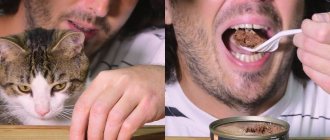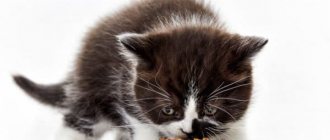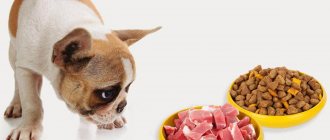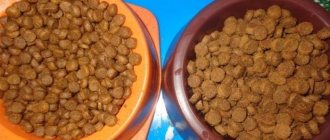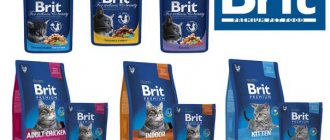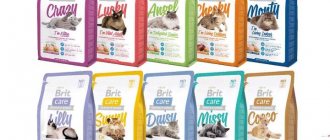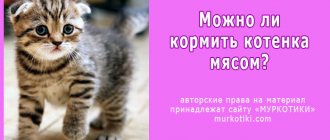People in whose homes live together pets belonging to different biological species, namely cats and dogs, often observe the phenomenon of stealing from someone else's bowl. Cats eat dogs' food, and the latter feast on the former's bowl. Many people do not pay much attention to this fact, especially if the pets do not fight about it. But caring owners of four-legged animals need to know whether it is possible to give their dog cat food and what consequences this may have.
Reasons why dogs love cat food
A dog can steal food from a neighbor's bowl for a variety of reasons. First of all, this is, of course, curiosity. Since animals have a much more acute sense of smell than humans, they are well aware that their neighbor has a completely different food in his bowl. And the dog has a question: maybe it’s tastier and better there. Of course you have to try it. In addition, manufacturers add flavorings to cat food to give the food an attractive smell. And the cheaper it is, the more similar compounds it contains. A dog, especially if it is fed natural food, may decide that cat food is much tastier. This assumption is strengthened by the fact that what is foreign is, in principle, always “sweeter.”
Another reason why a dog may eat cat food is simple: lack of food of its own. This may be real hunger, caused by the owner’s inattention or disregard for his responsibilities. Cats, as a rule, leave food in the bowl and can come up to eat quite often. This style of eating is typical for most of them. Dogs usually eat the entire portion at once. And if this is not enough for the animal, it may start stealing.
In another case, the cause is greed, aggression towards a cat living nearby, and the desire to take a leadership position. In this way, the dog may simply be trying to solve issues not directly related to nutrition.
Taste preferences of dogs and cats: nutritional characteristics and differences in diet
Canines and cats are carnivores. Wild cats hunt birds and rodents on their own and eat them whole. The victim's gastrointestinal tract contains plant fibers, carbohydrates, proteins, and food enzymes.
Small mammals eat grains, fruits, and vegetables. Complex carbohydrates are partially broken down into simple sugars. That's why cats love sweets; there is always a lot of glucose in their blood. The cat takes its prey to a secluded place and enjoys the food, eating it in small portions.
Wild dogs hunt in packs, mainly on small ruminants. Dominant individuals approach the prey first. The remaining members of the pack wait until the leaders are full, then pounce on the food, swallowing the pieces without chewing. Most of the contents of the gastrointestinal tract are occupied by feed containing coarse fiber - green or dry grass, tree bark.
Therefore, dogs are accustomed to eating food with a high concentration of fiber. If the dog is walking around the garden, he can eat bell peppers or grapes. Compassionate animal lovers feed their dogs bread.
Why you shouldn't give your dog cat food
Don't panic if you suddenly discover that your dog has tried food from the cat's bowl. Nothing wrong with that. These are not toxic substances, but quite normal food for the same living creature.
If a cat is fed high-quality food that belongs to the super premium or holistic category, then dogs are not at all prohibited from eating after the cat. These are foods containing useful vitamins, microelements, and beneficial compounds for good digestion. They contain a lot of meat, which is not contraindicated for a dog with a strong stomach.
The above does not apply at all to low-quality food in the economy and premium categories (for example, Kitecat or Whiskas).
The following cases are exceptions:
- the dog is allergic to the components of cat food, especially to proteins (manifested by various reactions, most often skin, up to the development of anaphylaxis), most often found in small breeds;
- after eating food intended for a cat, the dog feels sick, vomits, has obvious abdominal pain, indigestion;
- The dog is elderly, suffers from various diseases, and is not active.
In these cases, the owner should take measures to ensure that the dog cannot eat cat food under any circumstances.
Veterinarians categorically do not recommend giving your dog food intended for cats on a regular basis. This is due to the fact that the developers take into account the needs of the cat’s body, and they are very different from the needs of dogs.
Your dog should not be constantly fed cat food for the following reasons:
- Developers of cat food focus on the protein component, so the percentage of it in good quality products is quite high. This is due to the fact that the cat’s digestive tract works differently: it is adapted only to digest soft meat fibers, and does not accept plant foods well. An excess of protein is contraindicated for dogs: constant excess of protein leads to the development of problems with the cardiovascular, digestive systems, kidneys, liver, and provokes obesity.
- Food intended for feeding cats contains relatively little zinc and vitamin E. This amount is not enough for dogs, therefore, with constant consumption of cat food, a deficiency of these substances develops, which negatively affects the immune system, leads to metabolic disorders, insufficient absorption of fats and carbohydrates.
- Products for cats always contain taurine. For these animals, this amino acid is indispensable, so nutrition developers introduce it into feed. The dog’s body is capable of independently synthesizing it, and with constant intake from the outside, an excess of the substance develops. This threatens to change the acidity of the gastric environment and can provoke constant heartburn, which in the future can lead to the development of gastritis.
- Excess animal fats in cat food can also negatively affect the dog's health. Cats need more fatty acids, while in dogs, excess intake of these compounds can cause obesity and, as a result, many other health problems.
- High-end cat food contains a minimum of fiber; the body does not need so much of it. A deficiency in a dog can cause digestive disorders, and the animal will suffer from constipation.
May or may not be given
Dogs and cats belong to the order of carnivores, but need different nutrition. Cats prefer a meat diet, dogs are omnivores.
Cats have a fast metabolism: they eat often, but in small portions. One feeding per day is enough for the dog. This is explained by the level of glucose in the blood: in cats it is much higher.
Another difference has to do with taurine. It is responsible for the digestion of fats in the small intestine. Cats cannot synthesize it and are forced to obtain it through food. Due to a lack of amino acids, the functioning of internal organs, especially the heart, is disrupted. The canine body synthesizes them from animal proteins.
There is no universal food. You should not give your dog cat food because it will harm him.
The same goes for wet food. There is no need to offer dogs canned cat food. They contain a lot of fat, which is bad for the pancreas. If your dog eats dry or wet cat food, he will develop problems with digestion, liver, skin and fur.
Do not feed your puppy cat food! This will lead to allergies, intestinal upset and developmental delays.
How to wean
If a dog constantly steals food from a cat, it is necessary to wean it off. This not only spoils the health of the animal, but can also provoke a serious confrontation between pets. In this war, a third party - a person, as well as his property and nervous system - will suffer.
To wean your dog off cat food, you should follow these recommendations:
- Animals should be fed separately from each other, if possible, placing bowls in different rooms;
- you can try moving the cat's feeding area to a high place where the dog cannot get food from the bowl;
- if an animal really loves cat food and considers it a treat, then you should not give it as a reward during training; it is better to find another method of praise;
- if the dog is so accustomed to cat food that it refuses its own, then you can follow the principle and strictly limit access to the forbidden treat (nothing terrible will happen during a two-day hunger strike, but a psychological victory will be ensured).
You can also try to trick the dog. If he eats cat food for reasons of establishing leadership, thus showing aggression, then you can simply pour dog food into the cat’s bowl.
The owner’s task is to provide the pet’s body with all the necessary substances so that it is healthy and happy. Therefore, you should be very careful when feeding the animal and do not allow it to consume food that is not intended for it.
1111
Dog food classes
Products are divided into classes depending on quality and cost. Dog food is divided into:
- Economy class. These products are most often advertised, but they are not that safe for animals. In the composition you can see corn and legume ingredients, a large number of plant components, and animal proteins. The granules are painted in a variety of bright colors. In addition, the products contain salt.
- Premium class. These are, so to speak, popular varieties of dog food. They are all fortified and suitable for complete feeding of healthy pets.
- Holistic class. This is the best food. This variety does not contain salt, but has a small amount of preservatives. The food has a natural base.
- Medicinal feed. They are used only with the permission of a veterinarian.
- Special food for pregnant or weakened dogs.
Protein
It would seem, what could be wrong with protein? Is it possible to give cats food to dogs, despite its high protein content? The issue is much more complex than it might seem at first glance.
When creating food, manufacturers try to take into account the protein needs of animals, which vary greatly and depend on factors such as:
- view;
- breed;
- size;
- age;
- active lifestyle;
- presence of diseases;
- stress;
- pregnancy;
- castration.
It is known that the protein requirement of cats is higher than that of dogs. At the same time, an excess of protein in the diet negatively affects animals with kidney disease.
Your dog has kidney failure and you're wondering if you can feed your dog cat food? The consequences of such a diet, unfortunately, will be disappointing for your pet.
How are foods differentiated based on dog age?
There are also feeds:
- Food for puppies from 2 weeks to 2 months.
- For dogs and puppies from 2 months to 10 months.
- For dogs from one to 8 years old.
- And for dogs over 6 years old.
There are special foods for dogs from 6 to 7 years old. When choosing, it is worth considering some nuances. You should not feed an adult dog puppy food. Before choosing a particular product, it is advisable to consult a veterinarian.
In addition, on each food package you can find information about the required feeding doses for each specific weight of the pet, and special dietary formulations are being developed for dogs prone to obesity.
No competition
It happens that a dog living together with a cat in the same house can eat its food. She does this, as a rule, for reasons of competition.
Here we can advise the following: you need to place your pets’ bowls in different rooms or place them at different heights. In the latter case, the cat's dishes can be placed on a table or windowsill to prevent the dog from reaching food that is not suitable for it.
Thus, the main rule in feeding a pet is to give it a diet that is adequate for its age, size, special needs and... species. The cat should receive food formulated for cats. Dog - diets for dogs.
Photos: Collection/iStock
Basic misconceptions
As a rule, owners believe that pet food is to some extent interchangeable. There are the following misconceptions:
- All pet food is approximately the same, and all differences are the machinations of unscrupulous marketers. Do you really think so? Look at the composition. Even food for dogs of different ages and breeds is very different, let alone food for cats and dogs.
- Cats and dogs are domesticated carnivores and are fed approximately the same diet. Well, yes, and children, adults and pensioners are people, but for some reason it is not recommended for them to eat the same thing. Theoretically, we, of course, can eat the same thing, but an adult may experience: an allergy to lactose, gastrointestinal problems, protein deficiency and other health problems due to baby food. Animals also have their own characteristics.
- It all depends on how to feed your dog dry cat food: given the size of the shepherd, she just needs to be given a little more food than a cat. Once again, we suggest you look at the composition: cat food contains substances that are generally not recommended for dogs. Is cat food bad for dogs? Of course, therefore, if you increase the dose, the consequences can be very unpleasant for the health of the animal.
- The animal’s body itself knows what it needs and what it doesn’t, so if a dog eats cat food, it means it has a need for it on a physiological level. Remember how last New Year your cat ate the rain from the Christmas tree? How did your dog eat all the plastic pens and your new shoes? Can a dog eat dry cat food because her body thinks she needs it? No comments.
Useful tips
- Make sure your pets always have clean water freely available. Nothing will happen if the animal gets a little hungry. Lack of fluid can lead to dehydration.
- Try making a cat feeding house from a cardboard box. Cut a small hole on the side through which she can fit without the dog reaching her there.
- Don't use physical punishment. They can cause injury to small joints and traumatize the animal’s psyche. The maximum is a light slap with a rolled-up newspaper on the nose or lower part of the body.
Nothing will happen if the dog is fed cat food once in case of emergency. But the pet’s body must receive all the substances necessary for health. The owner’s task is to carefully monitor the balance of feeding and try to avoid junk food, even if the pet likes it.
Protein Digestibility
The health of a pet is affected not only by the presence of protein in the diet, but also by how easily it is absorbed by the body. Digestibility is influenced by many factors. For example, you should consider the source of the protein and at what temperature the product was processed.
As a rule, animal protein is better absorbed than plant protein. However, there are exceptions, such as soy protein. At the same time, among animal proteins, proteins from connective tissue are better absorbed than proteins from skeletal muscles.
Given this information, is it possible to feed a cat dry dog food? Yes, but it will bring absolutely no benefit. Dog food contains more vegetable protein, which is practically not absorbed by the cat's body. It turns out that the cat will spend internal resources on receiving and digesting food, but will not receive any useful substances from it, and, in some cases, even calories (if the level of undigested protein is 50-100%).
With a prolonged stay on such a diet, your pet may develop: vitamin deficiency, protein deficiency and various gastrointestinal disorders.
Composition of dry and wet
As mentioned above, cats consume fish, so fish, salts and salted meat are added to dry cat food. The amount of protein in them is quite high, and there is practically no fat . Canned food contains a small amount of vegetables, as well as a thick broth.
Dry dog food contains poultry, rabbit and beef. Protein and fat are in approximately equal proportions. Canned food is made from animal meat, sometimes crackers or pieces of meat jelly are added.
